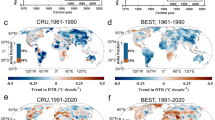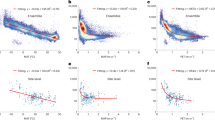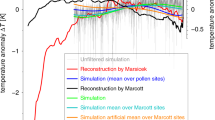Abstract
Warming mean temperatures over the past century1 have probably shifted distributions2, altered phenologies3, increased extinction risks4,5, and impacted agriculture6 and human health7. However, knowledge of mean temperatures alone does not provide a complete understanding either of changes in the climate itself or of how changing climate will affect organisms8,9,10,11. Temporal temperature variation, primarily driven by daily and annual temperature cycles, has profound effects on organism physiology8,9 and ecology12, yet changes in temperature cycling over the past 40 years are still poorly understood1,13. Here we estimate global changes in the magnitudes of diurnal and annual temperature cycles from 1975 to 2013 from an analysis of over 1.4 billion hourly temperature measurements from 7,906 weather stations. Increases in daily temperature variation since 1975 in polar (1.4 °C), temperate (1.0 °C) and tropical (0.3 °C) regions parallel increases in mean temperature. Concurrently, magnitudes of annual temperature cycles decreased by 0.6 °C in polar regions, increased by 0.4 °C in temperate regions, and remained largely unchanged in tropical regions. Stronger increases in daily temperature cycling relative to changes in annual temperature cycling in temperate and polar regions mean that, with respect to diurnal and annual cycling, the world is flattening as temperate and polar regions converge on tropical temperature cycling profiles.
This is a preview of subscription content, access via your institution
Access options
Subscribe to this journal
Receive 12 print issues and online access
$209.00 per year
only $17.42 per issue
Buy this article
- Purchase on Springer Link
- Instant access to full article PDF
Prices may be subject to local taxes which are calculated during checkout



Similar content being viewed by others
References
Hartmann, D. L. et al. in Climate Change 2013: The Physical Science Basis. (eds Stocker, T. F.et al.) Ch. 2, 226–229 (IPCC, Cambridge Univ. Press, 2013).
Parmesan, C. Ecological and evolutionary responses to recent climate change. Annu. Rev. Ecol. Evol. Syst. 37, 637–669 (2006).
Both, C., Bouwhuis, S., Lessells, C. M. & Visser, M. E. Climate change and population declines in a long-distance migratory bird. Nature 441, 81–83 (2006).
Mantgem, P. J. v. et al. Widespread increase of tree mortality rates in the western United States. Science 323, 521–524 (2009).
Lane, J. E., Kruuk, L. E. B., Charmantier, A., Murie, J. O. & Dobson, F. S. Delayed phenology and reduced fitness associated with climate change in a wild hibernator. Nature 489, 554–557 (2012).
Battisti, D. S. & Naylor, R. L. Historical warnings of future food insecurity with unprecedented seasonal heat. Science 323, 240–244 (2009).
Myers, S. S. et al. Human health impacts of ecosystem alteration. Proc. Natl Acad. Sci. USA 110, 18753–18760 (2013).
Vasseur, D. A. et al. Increased temperature variation poses a greater risk to species than climate warming. Proc. R. Soc. B 281, 20132612 (2014).
Paaijmans, K. P. et al. Influence of climate on malaria transmission depends on daily temperature variation. Proc. Natl Acad. Sci. USA 107, 15135–15139 (2010).
Reside, A. E., VanDerWal, J. J., Kutt, A. S. & Perkins, G. C. Weather, not climate, defines distributions of vagile bird species. PLoS ONE 5, e13569 (2010).
Li, Y., Huang, Y., Bergelson, J., Nordborg, M. & Borevitz, J. O. Association mapping of local climate-sensitive quantitative trait loci in Arabidopsis thaliana. Proc. Natl Acad. Sci. USA 197, 201007431 (2010).
Walther, G-R. et al. Ecological responses to recent climate change. Nature 416, 389–395 (2002).
Stine, A. R., Huybers, P. & Fung, I. Y. Changes in the phase of the annual cycle of surface temperature. Nature 457, 435–440 (2009).
Rosenzweig, C. et al. in Climate Change 2007: Impacts, Adaptation and Vulnerability (eds Parry, M. L.et al.) 79–131 (IPCC, Cambridge Univ. Press, 2007).
Sinervo, B. et al. Erosion of lizard diversity by climate change and altered thermal niches. Science 328, 894–899 (2010).
Levins, R. Evolution in Changing Environments: Some Theoretical Explorations (Princeton Univ. Press, 1968).
Ruel, J. J. & Ayres, M. P. Jensen’s inequality predicts effects of environmental variation. Trends Ecol. Evol. 14, 361–366 (1999).
Dell, A. I., Pawar, S. & Savage, V. M. Systematic variation in the temperature dependence of physiological and ecological traits. Proc. Natl Acad. Sci. USA 108, 201015178 (2011).
Deutsch, C. A. et al. Impacts of climate warming on terrestrial ectotherms across latitude. Proc. Natl Acad. Sci. USA 105, 6668–6672 (2008).
Yang, L. H. & Rudolf, V. H. W. Phenology, ontogeny and the effects of climate change on the timing of species interactions. Ecol. Lett. 13, 1–10 (2010).
Bauerfeind, S. S. & Fischer, K. Simulating climate change: Temperature extremes but not means diminish performance in a widespread butterfly. Popul. Ecol. 56, 239–250 (2014).
Karl, T. R., Knight, R. W. & Plummer, N. Trends in high-frequency climate variability in the twentieth century. Nature 377, 217–220 (1995).
Seneviratne, S. I. et al. in Managing the Risks of Extreme Events and Disasters to Advance Climate Change Adaptation (eds Field, C. B.et al.) 109–230 (IPCC, Cambridge Univ. Press, 2012).
Gilman, S. E., Wethey, D. S. & Helmuth, B. Variation in the sensitivity of organismal body temperature to climate change over local and geographic scales. Proc. Natl Acad. Sci. USA 103, 9560–9565 (2006).
Stine, A. R. & Huybers, P. Changes in the seasonal cycle of temperature and atmospheric circulation. J. Clim. 25, 7362–7380 (2012).
Chaves, L. F. & Pascual, M. Climate cycles and forecasts of cutaneous leishmaniasis, a nonstationary vector-borne disease. PLoS Med. 3, e295 (2006).
Mudelsee, M. et al. Climate spectrum estimation in the presence of timescale errors. Nonlinear Process. Geophys. 16, 43–56 (2009).
Kearney, M., Porter, W. P., Williams, C., Ritchie, S. & Hoffmann, A. A. Integrating biophysical models and evolutionary theory to predict climatic impacts on species’ ranges: The dengue mosquito Aedes aegypti in Australia. Funct. Ecol. 23, 528–538 (2009).
Dillon, M. E., Wang, G. & Huey, R. B. Global metabolic impacts of recent climate warming. Nature 467, 704–706 (2010).
Hay, S. I. et al. Climate change and the resurgence of malaria in the East African highlands. Nature 415, 905–909 (2002).
Acknowledgements
G.W. was supported in part by NSF IOB-041684 awarded to R. B. Huey and in part by the Max Planck Institute via D. Weigel. M.E.D. was supported in part by an NSF Minority Postdoctoral Fellowship and by the University of Wyoming. R. J. Hijmans provided assistance with the shoreline distance algorithm. We gratefully acknowledge R. B. Huey, M. R. Frazier, T. L. Daniel, S. Sane, J. Theobald, B. Rowan, J. Edwards and C. Martinez del Rio for fruitful discussions and comments on early versions of the manuscript. Computational resources were provided by the MPI Tuebingen and the UW Department of Geology.
Author information
Authors and Affiliations
Contributions
G.W. and M.E.D. conceived the methodology. G.W. built the data set and processed the data. M.E.D. and G.W. analysed the data and wrote the manuscript.
Corresponding author
Ethics declarations
Competing interests
The authors declare no competing financial interests.
Supplementary information
Rights and permissions
About this article
Cite this article
Wang, G., Dillon, M. Recent geographic convergence in diurnal and annual temperature cycling flattens global thermal profiles. Nature Clim Change 4, 988–992 (2014). https://doi.org/10.1038/nclimate2378
Received:
Accepted:
Published:
Issue Date:
DOI: https://doi.org/10.1038/nclimate2378
This article is cited by
-
Exploring the asymmetry and rate of SAT warming over the global land area under the 1.5 °C and 2 °C climate change targets
Meteorology and Atmospheric Physics (2023)
-
Longitudinal patterns of diversity and secondary production in a large regulated river
Hydrobiologia (2023)
-
It is about time: effects of thermal fluctuations resulting from climate change on trophic interactions with a focus on host–parasitoid interactions
Evolutionary Ecology (2023)
-
Concerns of assuming linearity in the reconstruction of thermal maxima
Nature (2022)
-
The neritic marine copepod Centropages typicus does not suffer physiological costs from diel temperature fluctuations associated with its vertical migration
Aquatic Sciences (2022)



